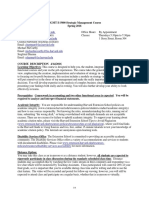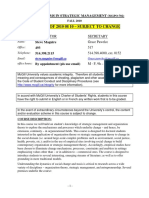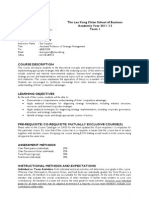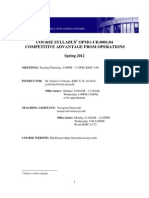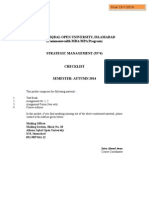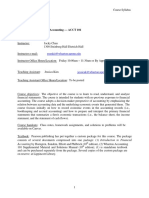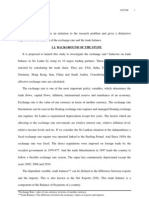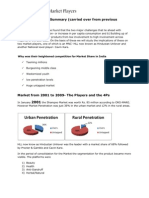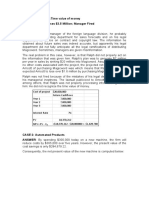2016C MGMT611001
2016C MGMT611001
Uploaded by
Chaucer19Copyright:
Available Formats
2016C MGMT611001
2016C MGMT611001
Uploaded by
Chaucer19Original Description:
Original Title
Copyright
Available Formats
Share this document
Did you find this document useful?
Is this content inappropriate?
Copyright:
Available Formats
2016C MGMT611001
2016C MGMT611001
Uploaded by
Chaucer19Copyright:
Available Formats
MANAGEMENT 611: MANAGING THE ESTABLISHED ENTERPRISE
Fall 2016
Professor Matthew Bidwell — 2020 Steinberg Hall-Dietrich Hall /215.746.2524/
mbidwell@wharton.upenn.edu
Professor Natalya Vinokurova — 2033 Steinberg Hall-Dietrich Hall /215.746.1996/
natalyav@wharton.upenn.edu
Professor Minyuan Zhao — 2014 Steinberg Hall-Dietrich Hall /215.746.3129/
myzhao@wharton.upenn.edu
Faculty websites
Prof. Bidwell: https://mgmt.wharton.upenn.edu/profile/1385/
Prof. Vinokurova https://mgmt.wharton.upenn.edu/profile/21183/
Prof. Zhao: https://mgmt.wharton.upenn.edu/profile/27458/
The management of large, established enterprises creates a range of multi-faceted challenges for the general
manager. A general manager needs to understand the internal workings of a firm, how to assess and create a
strategy, and how to take into account increasing globalization. While these issues are distinct, they are very
much intertwined. As a result, this course will provide you with an integrated view of these challenges and
show you that successful management in the 21st century requires a combination of insights drawn from
economics, sociology, psychology and political economy. The course has three main parts, and two “bookend”
events. The course starts with a class in which you will meet your entire teaching team and receive a road-map
for this semester-long journey.
The first part of the course explores the successful management of individuals and groups. We stress the fact
that organizational life is built around a complex interplay of social forces. Networks of cooperation, group
conflicts, systems of power and influence, career paths, and reward systems shape how people and
organizations manage and are managed. In this part of the course, we will create a framework for analyzing the
impact of these social forces on individuals, groups, and the organization. In particular, we study how to
motivate and lead those you manage. Moreover, we will study how to develop and implement organizational
designs and human resource systems that achieve competitive advantage through the management of people.
The second part of the course will deal with fundamental issues of strategy, examining issues central to the
long- and short-term competitive position of an enterprise. We will develop a set of analytical frameworks that
enable you to explain performance differences among firms and that provide a structure for strategic decisions
to enhance firms’ future competitive positions. We will cover both strategy at the business unit level,
introducing tools of industry analysis and competitive positioning, and at the corporate level, examining the
economic logic for firms to diversify across businesses and for vertical integration decisions across stages of
the industry value chain.
The third part of the course covers the unique opportunities and challenges that firms face when doing
business across borders, and the strategies that they can deploy based on the country- and firm-specific
characteristics. While reinforcing the learning points covered in the previous two parts of the course, the
discussions in this part will emphasize the deep and persistent cross-country differences in economic, political
and social institutions. We will also discuss how exchange rate volatilities, trade and investment treaties, new
technologies, and new business models are shaping the business landscape for multinational enterprise.
MANAGEMENT 611, FALL 2016 -1-
The class concludes with your projects, showing how these different perspectives on organizations can be
brought together to understand how established enterprises can be successfully managed.
TEXT AND READINGS
Wharton Reprographics has a copy of the course pack for MGMT 611, which can be purchased from
Study.Net.
The readings listed on the course outline below should be read and prepared before that class session.
PLEASE NOTE
This class is heavily participation based. Any students who fail to attend the first class will lose their
seats in the class. Repeated absences from the class will result in a failing grade independently of
your performance on the other assignments.
ASSIGNMENTS, QUIZZES AND EXAMS
Project Proposals Due: Tuesday 13th of September at noon
Human and Social Capital paper: Friday 30th of September at noon
Strategy paper: Wednesday 2nd of November at noon
Global Strategy paper: Friday 2nd of December at noon.
Final paper presentations: 5th and 7th of December
Final paper: Thursday December 8th at noon.
Please submit all assignments via Canvas.
CLASS SESSIONS AND PARTICIPATION
Each class will consist of a combination of lecture and discussion of the day’s topic. On most days, we will
use case analysis to explore the issues at hand. Careful preparation is essential. We expect you to read all of
the assigned materials for each session in advance of the class. In class, you should be prepared to analyze the
concepts from the case and the readings and to discuss any questions provided in the syllabus. If you cannot
answer the questions, you are not prepared for class. We will use cold calling to ensure preparation and to
establish an even level of participation throughout the course.
We expect you to participate actively in class to help your learning and that of your peers. A productive
learning environment requires active engagement of all class members. Three factors determine good class
participation. First, given thorough and careful preparation, you should be able to identify the important
managerial issues related to the case and/or readings. Second, you should be able to use that analysis to define
a concise and logical position on the issues. Please avoid pure repetition of case facts. You should be able to
show how a particular concept is illustrated in the case or suggest how the substantive problem presented in
the case can be solved. Third, you should be able to analyze constructively the positions your classmates take.
Quality, not quantity, will determine the effectiveness of your comments. “Airtime hogs” will not be
rewarded.
Of course, the underlying condition for class participation is attendance. We expect you to attend all sessions.
Specifically, according to the MBA office, there is no recruiting reason for which you should miss class. If you
cannot come to class, you should notify your instructor by email in advance of the class. Finally, in order to
facilitate lively, in-depth discussions and out of respect for each other, there are two simple ground rules
regarding mobile devices and laptop computers: 1) please remember to turn off your phone, Blackberry
and/or other communication devices; and 2) no laptops open during class.
CASE DISCUSSIONS
In preparing cases for discussion in class, you should be ready to comment on (1) the case’s background and
context, (2) the key issues and problems, (3) a framework for analyzing the issues and problems, (4) the
implications of the assigned readings for understanding the case, and (5) a course of action for designing and
implementing solutions.
MANAGEMENT 611, FALL 2016 -2-
GRADING
Your grade will be based on:
Class participation (20%) which will be graded by all three instructors and equally weighted across
sessions. Because participation is a critical part of the learning experience, unexcused absences will be
heavily penalized.
Three individual assignments – a Human and Social Capital paper (20%), a Strategy memo (20%),
and a Global Strategy paper (20%).
The team final paper and team project presentation (20%). The team project grade will depend in part
on a within team assessment of each member’s contribution.
It is possible to fail this class.
FACULTY LUNCHES
We have scheduled a number of informal lunches with the course faculty. These are totally optional. You
may sign up for lunch on the Canvas page for your section.
ETHICS AND USE OF PRIOR MATERIALS
It is never appropriate to use materials prepared by students or faculty in this course from previous years. You
should not use previously completed case write-ups, or summaries of readings.
HUMAN CAPITAL PAPER: WRITTEN ANALYSIS OF PREVIOUS EMPLOYMENT
Due at Noon, Wednesday September 23rd
Your assignment is to examine your last job (or an earlier job) and use theories and concepts from the course
to analyze and explain your work experience. Essentially, in this assignment, you will use your job as the case
material that allows you to demonstrate your understanding of course theories/concepts. You may use course
materials from Sessions 2-8 in which we cover such topics as motivation, job design, reward systems,
managing individual and group performance, and group and organizational influences on decision-making.
Certain readings focus on specific theories (e.g. expectancy theory; equity theory) that provide a full-fledged
framework for explaining and predicting behavior; while other readings include concepts that may not be full
theories but can be abstracted and applied to a wide range of situations, e.g. Rewarding A While Hoping for B
(Kerr).
The choice about what issues to cover and what theories/concepts to apply is yours. In evaluating your
answer, we will look to see whether the theories/concepts you use are described accurately (i.e. substantively
correct), applied appropriately (i.e. fit the job situation you describe), and most relevant to the situation (i.e. did
you pick the theories/concepts that best illuminate your situation).
In analyzing your job, focus on how you were managed, not how you behaved in managing others. It does
not matter whether you had a good job experience or a bad job experience. You can talk about both the
successful and the unsuccessful aspects of the job, and about what was missing for you. The paper presents
you with an opportunity to explore in-depth the course readings, master them, and apply them to your
experience. Thus, very good papers do not simply present a lively and detailed description of your past job. Rather, they
demonstrate in-depth understanding and application of course concepts and theories. More specifically, they:
1. Demonstrate in-depth understanding of a minimum of three theories/concepts from Sessions 2-8 by
making specific links between theories/concepts and key elements of your job experience.
2. Explore (and demonstrate your understanding of) the similarities, complementarities, or inconsistencies
among the theories and concepts (i.e., do the theories/concepts fit together and reinforce each other or
do they disagree? How do they complement each other? Conversely, how are they inconsistent or
conflicting?)
3. Explain why the theories or concepts you’ve chosen are important and useful for understanding (and
perhaps for suggesting changes to) your prior job or organization.
MANAGEMENT 611, FALL 2016 -3-
Here are some tips based on our collective experience with this course assignment. Each instructor will offer
additional guidance with his/her specific expectations and recommendations.
Don’t forget that this is an exercise that must be graded. It is easy to get carried away with an
interesting story and forget that this is also a way to test your knowledge of and ability to apply the
course material.
In a relative comparison (which is how we evaluate these papers), applying more theories is better than
applying fewer theories, with two caveats: you need enough rich descriptive material about your job so
we can understand it, and you need to cover each theory thoroughly enough that we are sure you know
how to apply it. It is definitely possible to include too many theories and concepts if they are covered so
superficially that your knowledge cannot be convincingly displayed. The way the paper is graded, you
need to apply a minimum of three different theories or frameworks. More than five is probably too
many.
Be sure to explore your personal experience with your job, rather than writing generically about the
experience of all people in positions like yours.
Remember to mention course concepts specifically, so we don’t have to read your mind to figure out
what concepts you are applying to your work experience. Drawing explicit links between the concepts
you identify and the case material is the key. Don’t just drop in the names of a few theories or
concepts into the midst of describing your job. Show how they apply to your situation.
It may be useful to develop a comparative angle in the paper, i.e. compare how your job experience
varied for two different tasks or compare your job before and after a change in your boss or a
company restructuring.
Comparing and contrasting how two or more different theories can be applied to the same aspect of
your job situation is another effective strategy. Be sure you make it clear to us why you chose those
theories and which you felt provided more insight.
The write-up should be printed double-spaced, using a normal font-size. The maximum length is 1,000 words
(plus or minus 5%). Please include a word count on the front page. You will have to be concise and make
choices about what issues to discuss. We recommend that you begin work on the paper early, to avoid the
mid-semester crunch. This is feasible because the raw material (your work experience) is readily available to
you and each class session will introduce new concepts that are potentially applicable.
This is an individual assignment, and should be done individually.
STRATEGY MEMO
Due at Noon, Wednesday November 2nd
1. Conduct an industry analysis of the last industry you worked in from the perspective of an incumbent
firm.
2. Draw the activity system for your last employer.
3. Discuss 2 or 3 interactions within the activity system you drew (i.e., the reasoning behind why you have
connected 2 elements in the activity system).
The paper should be no more than 1,000 words, i.e., about 3 pages, with one additional page depicting the
activity system. Each of the three parts of the paper will have an equal weight for grading purposes.
This is an individual assignment, and should be done individually.
GLOBAL STRATEGY PAPER
MANAGEMENT 611, FALL 2016 -4-
Due at Noon on Friday, December 2nd
Pick a firm you are interested in. You are now hired as an internal consultant to assess the firm’s global
strategy, and are asked to give recommendations for the future. Note that it is perfectly fine if you recommend
the firm to remain a pure-play domestic company with no foreign presence at all, even though it may still be
exposed to global economic forces.
Please read the following instructions carefully before you get started.
Your submission should take the form of a letter to the top management team of the focal company,
in a Word or PDF file. Your letter should be no more than 1,000 words, including figures and tables,
with an additional page for references.
This is an individual assignment. You may refer to books, class handouts, and financial reports from the
company, but have to write the answers in your own words, unless accompanied with quotation marks
and references.
Your letter must contain answers to the following questions:
a. What do you think are the main competitive advantages of the focal company? How are these
advantages related to the home country business environment it is (or was) in?
b. Focus on one country that the company has entered (host country) or is considering (potential
host country). How does it compare with the home country, along the dimensions that are
relevant to the firm’s business? Do you think entering that country would leverage or enhance
the focal company’s competitive advantages as outlined in a.?
c. Suggest the right entry strategy, taking into consideration both the economic factors and the
institutional environment of the (potential) host country. If the firm has already entered the
host country, please comment on its current strategy, and offer your suggestions. Please try to
be as explicit as you can.
d. How does the firm’s global strategy—or its decision to stay domestic—affect its overall
competitiveness in the industry?
Use the concepts and frameworks discussed in class, but please be selective. Do not run a laundry list
of all the factors. Instead, find the ones most relevant to this firm, and explain why they should demand
attention from the top executives (i.e. busy people). Be explicit about the firm-, industry-, and country-
specific characteristics.
Do not spend too much time searching for information. Instead, think hard on the best ways to
approach the questions. If some crucial information is not readily available, let us know how to obtain
the information or how to make decisions with incomplete information (which we do all the time).
Sound understanding of concepts and logical clarity in your writing are more important than the amount
of information compiled.
This is an individual assignment, and should be done individually.
THE TERM TEAM PROJECT
Due at Noon on Thursday, December 8th
The team project should be carried out in groups of 5. You are free to choose your team members yourself.
Part of the grade will depend on a within team evaluation of the contributions made by each member.
Your assignment is to use theories and concepts from the course to analyze and explain the activities of a
given firm located in a given country, vis-à-vis the firm’s employment practices and organizational and human-
resource systems, its corporate strategy, and its global strategy. Essentially, in this assignment, you will use an
actual firm as the case material that allows you to demonstrate your understanding of and ability to apply
course theories/concepts. The project can incorporate such competitive strategy topics as industry analysis,
positioning, firm capabilities and resources, and the horizontal, vertical and geographic boundaries of the firm;
MANAGEMENT 611, FALL 2016 -5-
such human and social capital course topics as motivation, job design, reward systems, recruiting and selection,
managing individual performance, and links between the HR system and business strategy; and global
strategies of aggregation, adaptation and arbitrage, the role of business groups and the tension between
shareholder value maximization and stakeholder demands. This assignment requires you to prepare a report
(25 pages in length) and a presentation summarizing its main themes and findings. For both, you should
consider the drivers of the firm’s recent relative performance as well as the sustainability of these drivers over
time.
The choice about the relative weight to put on different issues, theories and concepts in explaining the firm’s
activities and its performance is yours. In evaluating your paper, we will look to see whether the
theories/concepts you use are described accurately (i.e. substantively correct), applied appropriately (i.e. fit the
context you describe), and most relevant to the situation (i.e. did you pick the theories/concepts that best
illuminate the firm’s situation). In choosing a focal firm, remember that you may not choose a firm highlighted
in the cases from the course; and that the firm must, to some degree, be global, i.e. involved in cross-border
activities (not only serving a domestic market).
Please consider the following suggested sections to include in your report:
• Short history/overview of the focal firm, its strategy, and its management practices, including the
influence of its home country’s political, economic and social institutions;
• Short history / overview of the economic, political, legal or social context in the focal country and the
focal firm’s perceptions of their likely evolution over time, as it pertains to the evolution of the focal
firm’s strategy and management practices;
• Industry analysis, both globally and in the focal national market;
• Management challenges, including (but not limited to) organizational design, structure, and processes;
culture, i.e., how the firm’s culture deals with differences in national culture that affect its activities;
and HR practices related to rewards, skills/talent, hiring and retention, job design, supervision and
performance appraisal;
• Is this company considering a global expansion or contraction? Does it make sense for the company
to expand globally at this time? Why or why not?
• If the company were to expand globally beyond its current geographic scope, which regions make the
most sense? (CAGE framework) Why?
• How much adaptation of product attributes or marketing does this company do as it moves across
different geographies? Should it do more? Less?
• Global strategy (i.e., Aggregation, Adaptation or Arbitrage) of the firm in the focal market
differentiating by product or function as appropriate, and including mode of entry and sequence of
entry by which the firm entered the focal market where appropriate;
• Impact of different national employment laws, policies, institutions, and norms on the focal firm
when it operates in different counties (Porter Diamond, Institutional Voids);
• What is the nature of the competitive forces within the industry currently and how are these dynamics
likely to change in the near and medium term?
• How this firm is positioned with respect to its industry competitors? Note that this analysis should
include both external (i.e. execution of the strategy vis-à-vis customers) and internal (i.e. organizational
practices that develop capabilities underlying the strategy) activities. Do these activities reinforce each
other, per the concept of an activity system?
• National positioning analysis – How does the focal country position itself to attract firms and
investment from within and outside national borders? Why did the focal firm choose to locate in this
particular country? What location choices are competitors making?
• Overall assessment of this firm’s competitive advantage – its sources, distinctiveness, imitability, and
the sustainability of its competitive position.
Here are some tips based on our collective experience with this course assignment. Each instructor will offer
additional guidance vis-à-vis specific expectations and recommendations.
• Don’t forget that this is an exercise that must be graded. It is easy to get carried away with an
interesting story and forget that this is also a way to test your knowledge of and ability to apply the
course material.
MANAGEMENT 611, FALL 2016 -6-
• Remember to mention course concepts specifically, so we don’t have to read your mind to figure out
what concepts you are applying to your case. Drawing explicit links between the concepts you identify
and the case material is the key. Don’t just drop in the names of a few theories or concepts into the
midst of a description. Show how they apply.
• Do not expect the reader to “crunch the numbers” that you display in your exhibits to see what is
really happening; this is the difference between a case and a paper: you have to provide the data and
the analysis.
• When facing a choice as to whether to narrow your paper to a more focused topic, recognize the
benefits of this strategy in terms of richness, thoroughness and completeness but balance these
benefits against the costs of reduced data availability and difficulty in legitimately speaking to all three
elements of the course. Choose the narrowest possible topic that offers sufficient data and allows you
to describe and integrate a discussion on corporate strategy, human and social capital and global
strategy.
• It may be useful to
o Develop a comparative angle in the paper, i.e. compare your firm to another firm in the same
country or your firm’s operations in the focal country to those in another country. Doing so,
however, enhances the risk of spreading yourself too thin so be cognizant of this risk if you
choose this approach.
o Compare and contrast how two or more different theories or frameworks can be applied to
the same case. Be sure you make it clear to us why you chose those theories and which you
felt provided more insight.
PLEASE NOTE THAT ANY QUOTATIONS OF LONGER THAN A PHRASE MUST BE
EXPLICITLY NOTED IN THE TEXT. INSUFFICIENT ATTRIBUTION TO EXTENDED
QUOTATIONS FROM EXTERNAL SOURCES WILL RESULT IN FORMAL CHARGES OF
PLAGIARISM TO THE OFFICE OF STUDENT CONDUCT. IF YOU HAVE ANY QUESTIONS ON
POLICY, SEE http://gethelp.library.upenn.edu/PORT/documentation/plagiarism_policy.html
A one page proposal that describes the company you are planning to study, what aspects your analysis will
focus on, and how you plan to gather data should be submitted on Canvas by Tuesday 13th of September.
You should then meet with faculty at the end of February to discuss your progress.
The write-up should be printed double-spaced, using 12-point Times New Roman Font. The maximum length
is 25 pages not including Exhibits. Please include an Executive Summary and Word Count on a title page. You
will have to be concise and make choices about what issues to discuss. We recommend that you begin work on
the paper early, to avoid a last minute crunch. This is feasible because some corporate and national material is
readily available and each class session will introduce new concepts that are potentially applicable. You will also
do a presentation to the faculty and your classmates of your report’s primary themes and conclusions.
MANAGEMENT 611, FALL 2016 -7-
COURSE OUTLINE
Class 1: Introduction to Managing the Established Enterprise (31st of August)
• Case: “High Expectations: What a big pay rise at Walmart means for the minimum wage debate”
The Economist Jan 30th 2016
“Thinking Outside the Box: As American shoppers move online, Walmart fights to
defend its dominance.” The Economist June 2nd 2016
“Wal-Mart, thwarted by India's retail restrictions, goes big: wholesale,” Los Angeles Times,
July 23, 2015.
1. What do you see as Walmart’s overall strategy?
2. What alternative human capital strategies could they consider?
3. If you were CEO of Walmart, what countries would you enter first and which
countries would you defer for a later date?
Labor Day: No Class on September 5
Class 2: Motivating Individual Performance (7th of September)
Readings: Stephen P. Robbins and Timothy A. Judge, excerpts from “Motivation” (covers four
theories: needs, cognitive evaluation, goal-setting, expectancy), Organizational Behavior, 12th
edition, Englewood Cliffs, N.J.: Prentice Hall, pp. 192-198, 208-210.
Case: Kyle Evans at Ruffian Apparel
1. What do you see as the main problems with the current incentive system?
2. What changes would you make to the way that people are managed?
Class 3: Designing Reward Systems (12th of September)
Readings: Steven Kerr, “On the Folly of Rewarding A While Hoping for B,” Academy of Management
Journal, Vol. 18, pp. 769-83.
Stephen P. Robbins & Timothy A. Judge, “Equity Theory,” from Organizational Behavior,
12th edition, Englewood Cliffs, N.J.: Prentice Hall, pp. 203-207.
Case: Marshall and Gordon: Designing an Effective Compensation System (A)
1. What problems does Marshall and Gordon’s current compensation system create?
2. How might you adjust their incentive system to better align rewards with the firm’s
strategy? What do you think are the strengths and weaknesses of the system that
you have proposed?
One page project proposal due Tuesday 13th of September
MANAGEMENT 611, FALL 2016 -8-
Class 4: Designing Jobs (14th of September)
Readings: Talya Bauer, Berrin Erdogan (2013) “Motivating Employees Through Job Design”.
Section 6.2 in Organizational Behavior, Flat World Publishing
Please fill out the JDS survey (available on Canvas) for the first job that you held
after graduating. Bring the results to class.
Consider the worst job you’ve ever had, or perhaps a job in your most recent
workplace that seemed particularly dissatisfying and dispiriting. Apply the “Job
Characteristics Model” (Hackman et al.’s framework) to the job. What would you
change? Are such changes feasible? If not, why not? If so, why haven’t such
changes been implemented to date?
Class 5: Recruiting and Selecting Employees (19th of September)
Readings: Optional: Ann Marie Ryan & Nancy T. Tippins, “Attracting and Selecting: What
Psychological Research Tells Us”, Human Resource Management, Vol. 43: p. 305-318.
Case: SG Cowen: New Recruits
1. Who would you hire and why?
2. How will the change in recruiting strategy proposed by Chip Rae affect the nature
of the company and its culture?
3. What are SG Cowen’s goals for its recruiting process? Is SG Cowen meeting its
goals?
Class 6: Managing Individual Performance (21st of September)
Readings: John J. Gabarro and Linda A. Hill, “Managing Performance,” Harvard Business School (9-
496-022).
Case: Wolfgang Keller at Konigsbrau – TAK (A)
1. How would you assess Brodsky’s performance?
2. How well do you think Keller has managed Brodsky?
3. What actions should Keller take on returning to Kiev?
Class 7: Designing the Organizational Architecture (26th of September)
Readings Richard M. Burton, Borge Obel and Gerardine DeSanctis “Organizational Design, a
Step-by-Step Approach, Chapters 4 (pp59-75)
Case Jones Lang Lasalle: Reorganizing around the customer (2005)
1. What problems do you think that the current structure is causing for the firm?
What are the root causes of those problems?
MANAGEMENT 611, FALL 2016 -9-
2. Which or the proposed new organizational structures would you recommend? Why?
3. What recommendations would you make about how best to implement the
changes?
Class 8: Managing Human Resources for Organizational Performance (28th September)
Readings: Jeffrey Pfeffer, “Producing Sustainable Competitive Advantage Through the Effective
Management of People,” Academy of Management Executive, Vol. 19 (4): pp. 95-106.
Case: Southwest Airways: Using Human Resources for Competitive Advantage
1. What is Southwest’s strategy? How would it answer the question, “What business
are we in?” Why has it been successful for so long?
2. What aspects of the way that Southwest manages its people contribute to its
success?
3. Why did Southwest’s competitors struggle to replicate its success?
Friday, September 30th HUMAN AND SOCIAL CAPITAL PAPER DUE AT NOON
Class 9: Industry Positioning & Competitiveness (3rd of October)
Readings: Porter, Michael E. 2008. “The Five Competitive Forces that Shape Strategy.” Harvard
Business Review, January, pp. 79-93.
Case: Cola Wars Continue: Coke and Pepsi in 2010 (9-711-462)
1. Why, historically, has the soft drink industry been so profitable?
2. Compare the economics of the concentrate industry to that of the bottling
industry: Why is the profitability so different?
3. How has the competition between Coke and Pepsi affected the industry’s profits?
4. How can Coke and Pepsi sustain their profits in the wake of the flattening
demand and the growing popularity of non-CSDs?
Class 10: Complementors (5th of October)
Readings: Brandenburger, Adam M., and Barry J. Nalebuff. 1996. Co-opetition pp. 11–34.
Video: All Players in the Game: http://vimeo.com/62165898
Case: De Beers at the Millenium (9-706-518)
1. What product does De Beers actually sell?
2. What role does GIA play in the De Beers value net?
Class 11: Value Creation & Appropriation (10th of October)
MANAGEMENT 611, FALL 2016 - 10 -
Readings: Brandenburger, Adam, and Harborne Stuart. 1996. “Value-Based Business Strategy.”
Journal of Economics and Management Strategy 5 (1): 5–24.
Videos: A Definition of Value: http://vimeo.com/61143220
How the Pie is Divided: http://vimeo.com/61225993
1. To check your understanding of value creation and added value answer the
following questions:
Consider a set-up with four suppliers, three firms, and two buyers. Each supplier
can transact with at most one firm, and vice versa. Similarly, each buyer can
transact with at most one firm, and vice versa. Each supplier has an opportunity
cost of $10 of providing resources to a firm. Each buyer has a willingness-to-pay
of $40 for the product of two low-quality firms (say firms 1 and 2) and a
willingness-to-pay of $50 for the product of one high-quality firm (say firm 3).
What are the possible price ranges for the products sold by the high-quality and
low-quality firms? Pick prices outside these ranges and convince yourself that these
prices are not possible.
Class 12: Positioning & Activity Systems (12th of October)
Readings: Porter, Michael E. 1996. “What is Strategy?” Harvard Business Review (November-
December): 61–78.
Case: Progressive Corporation, 9-797-109
What are the five key points in Porter’s article?
When reading the Progressive case, please have the following questions in mind:
1. What is Progressive’s positioning?
2. What are the characteristics of Progressive’s customers?
3. How are Progressive’s activities tailored to its position?
4. How do the activities fit with one another?
5. Should Progressive enter the standard segment?
Focused Recruiting Period, October 13-23
Class 13: Competitive Interactions (24th of October)
Readings: Porter, Michael E. 1980. Competitive Strategy Ch. 3, pp. 47–74.
Video: The Uncertainty in a Game http://vimeo.com/64599418
Case: Philips’ Compact Disc Introduction (B), 9-792-036
1. How does competitor analysis proposed by Porter fit into the notion of second-
order thinking in the video?
MANAGEMENT 611, FALL 2016 - 11 -
In solving the Philips case, be aware of what assumptions you are making, and whether
your results are robust to (small) changes in these assumptions.
2. Should Philips establish a U.S. plant at the beginning of 1983 or wait a year before
deciding? Why or why not? (You need to crunch numbers here!) Do not try to
draw a game tree! In this case, solving the problem without a tree is much easier.
Class 14: Corporate Strategy (26th of October)
Readings: Ghemawat, Pankjaj and Jan Rivkin. 2010. “Choosing Corporate Scope,” Strategy and the
Business Landscape (3rd ed.), Ch. 6, pp. 123 – 147.
Case: The Walt Disney Company: The Entertainment King, 9-701-035
Please make sure you understand the “two tests” Ghemawat and Rivkin are describing.
When reading the Disney case, please have the following questions in mind:
1. Why has Disney been successful for so long?
2. What did Michael Eisner do to rejuvenate Disney? Specifically, how did he
increase net income in his first four years?
3. Has Disney diversified too far in recent years?
Class 15: Strategic Planning and Strategy Wrap-Up (31st of October)
Readings: Gavetti, Giovanni, and Jan Rivkin. “The Use and Abuse of Analogies” (9-703-429)
Gavetti, Giovanni, and Jan Rivkin. “Analogical reasoning at Lycos”
1. What are the pitfalls of analogical reasoning?
2. Read the Lycos mini-case. Do you buy the analogy to traditional media Lycos’s
management team used to arrive at their decision? Does this analogy provide
Lycos’s managers with valid guidance?
Wednesday, November 2nd STRATEGY MEMO DUE AT NOON
Class 16: The Global Business Environment (2nd of November)
Readings: Ghemawat, Pankaj (2001) “Distance Still Matters: The Hard Reality of Global Expansion”
Harvard Business Review 79(8): 137-147.
“Fabric of a Trade Deal: U.S. Asks Vietnam to Cut Out Chinese Textiles,” Wall Street
Journal, June 24, 2015.
“How Brexit could hurt America.” Chicago Tribune, June 20, 2016.
Class 17: Managing Differences: Adaptation (7th of November)
MANAGEMENT 611, FALL 2016 - 12 -
Readings: Ghemawat, Pankaj (2007) “Managing Differences: The Central Challenge of Global
Strategy” Harvard Business Review 85(3): 58-68.
Mini case: “Amazon Invades India,” Fortune Magazine, January 1, 2016.
1. How should Amazon adapt in India? What should remain unchanged?
2. Is Amazon taking too much risk by investing in such a large scale? Why is Amazon
taking this approach in India but not in other countries?
Class 18: Managing Differences: Aggregation (9th of November)
Case: Ingvar Kamprad and IKEA (HBS 9-390-132)
1. Why is the traditional furniture industry highly fragmented?
2. What are consumers looking for when they buy furniture? And how does your
answer to this question determine the right globalization strategy for IKEA?
3. What are the major challenges faced by IKEA in its global expansion? How did it
overcome the challenges?
Class 19: Managing Differences: Arbitrage (14th of November)
Readings: Bremmer, Ian. (2014) “The New Rules of Globalization” Harvard Business Review Jan/Feb:
103-107.
Case: China Construction America (B) (HBS 911-411)
1. How has the states’ involvement in international business changed in recent years,
both in quantity and in format?
2. How much would you attribute CCA’s competition advantage to the state support?
What are the reasons for concern, both for CCA and its competitors?
Class 20: Emerging Market Multinationals (16th of November)
Readings: Khanna, Tarun, Krishna G. Palepu, and Jayant Sinha (2005) “Strategies That Fit Emerging
Markets,” Harvard Business Review 83(6): 63-76.
“Emerging Market Multinationals: New Giants on the Block,” Knowledge@Wharton, July 17,
2013.
Case: The Suzlon Edge (HBS 9-708-051)
1. How would you characterize emerging-market multinationals?
2. Does Suzlon’s integration strategy make sense? Why or why not?
3. What do you think are the biggest challenges Suzlon faces moving forward?
November 21-27 Thanksgiving Break
Class 21: Appropriating Value Globally from Intangible Assets (28th of November)
Readings: “The Two Faces of Intellectual Property in Brazil,” Knowledge@Wharton, March 01, 2006.
MANAGEMENT 611, FALL 2016 - 13 -
“Glaxo to Stop Seeking Drug Patents in Low-Income Countries,” Wall Street Journal, March
31, 2016.
Case: The Munich Oktoberfest: From Local Tradition to Global Capitalism (HBS 714-439)
1. Why is intellectual property (IP) such a controversial topic in global strategy?
2. What are the options for companies trying to appropriate value from their
intangible assets in the overseas markets?
3. Under what circumstances is NOT pursuing the IP rights the best strategy?
Class 22: Technology in Globalization: A Debate (30th of November)
“China has a new taxi app monopolist - and it isn't Uber,” Fortune, Feb 16, 2015.
“Uber Battles Locals for Future of African Taxis,” Wall Street Journal, May 18, 2015.
“Uber found guilty of starting ‘illegal’ car service by French court” Financial Times, June 9,
2016.
“Uber Rivals Form International Alliance,” Wall Street Journal, October 16, 2015.
“Russia’s Taxi-Hailing Apps Gain Ridership,” Wall Street Journal, January 7, 2016.
“India's Ola, Uber Rival, Goes One Up,” Forbes, November 17, 2015.
Friday, December 2nd GLOBAL STRATEGY MEMO DUE AT NOON
Class 23 and 24: Project Presentations (December 5th and 7th of December)
Thursday, December 8th TEAM PROJECT DUE AT NOON
MANAGEMENT 611, FALL 2016 - 14 -
You might also like
- Project-Based Learning in the Math ClassroomFrom EverandProject-Based Learning in the Math ClassroomRating: 5 out of 5 stars5/5 (1)
- Management 711 Competitive Strategy and Industrial StructureDocument11 pagesManagement 711 Competitive Strategy and Industrial StructureChaucer19No ratings yet
- M 611: Managing THE Established Enterprise: AnagementDocument14 pagesM 611: Managing THE Established Enterprise: AnagementceojiNo ratings yet
- M 611: Managing THE Established Enterprise: AnagementDocument14 pagesM 611: Managing THE Established Enterprise: AnagementChaucer19No ratings yet
- 2019a MGMT612001Document18 pages2019a MGMT612001Chaucer19No ratings yet
- MAN 336 Organizational Behavior Business Honors Program - Bartel 04295 & 04300Document18 pagesMAN 336 Organizational Behavior Business Honors Program - Bartel 04295 & 04300GeetvikNo ratings yet
- SGMT 3000T - Winter 2014 SyllabusDocument10 pagesSGMT 3000T - Winter 2014 Syllabuscricket1223No ratings yet
- Syllabus HarvardDocument8 pagesSyllabus HarvardAngelo KstllanosNo ratings yet
- MBA 406 Syllabus Fall 2011Document13 pagesMBA 406 Syllabus Fall 2011Syed Fahad AhmedNo ratings yet
- Core-Gp.1020.003 0Document20 pagesCore-Gp.1020.003 0Reza FahleviNo ratings yet
- BUSINESS 400-040 T-R 6:30 PM ED 621 2013 Spring SemesterDocument12 pagesBUSINESS 400-040 T-R 6:30 PM ED 621 2013 Spring SemesterJaspreet ChawlaNo ratings yet
- BU 481 2016S Course Syllabus - FinalDocument12 pagesBU 481 2016S Course Syllabus - FinalJoshNo ratings yet
- SyllabusDocument10 pagesSyllabus임민수No ratings yet
- Ucd Smurfit School of Business MSC International Management (Cems) BMGT 43510 Strategic ManagementDocument11 pagesUcd Smurfit School of Business MSC International Management (Cems) BMGT 43510 Strategic ManagementChristian BauerNo ratings yet
- Course Outline RSM392H1: Generalizable Lessons About Why Some Firms Outperform OthersDocument10 pagesCourse Outline RSM392H1: Generalizable Lessons About Why Some Firms Outperform OthersJoe BobNo ratings yet
- Analysis of Business StrategiesDocument12 pagesAnalysis of Business StrategiesFawad Ahmed ArainNo ratings yet
- MGMT 699 Reusch 201201Document7 pagesMGMT 699 Reusch 201201Siju BoseNo ratings yet
- Examples StrategyDocument24 pagesExamples StrategyAanchal VijhNo ratings yet
- Mgmt218 Patrick LohDocument6 pagesMgmt218 Patrick LohSimon HoNo ratings yet
- MOR 465 SyllabusDocument8 pagesMOR 465 SyllabussocalsurfyNo ratings yet
- 5563 AssignmentDocument21 pages5563 AssignmentAtif AliNo ratings yet
- Neubaum MAN 6721 Fall 2019 2Document9 pagesNeubaum MAN 6721 Fall 2019 2jorge scharffenorthNo ratings yet
- StratDocument14 pagesStratseanNo ratings yet
- 7.IEE3293 - STRATEGIC MANAGEMENTÀÌÈ ¿Í Ö ÔP2Document5 pages7.IEE3293 - STRATEGIC MANAGEMENTÀÌÈ ¿Í Ö ÔP2sephranesabajoNo ratings yet
- Syllabus 410 Caro 2011 SummerDocument11 pagesSyllabus 410 Caro 2011 SummerMindaou_Gu_3146100% (1)
- SMM861-Syllabus - 2016 - 18 Feb 2016Document13 pagesSMM861-Syllabus - 2016 - 18 Feb 2016Pallavi GuptaNo ratings yet
- Ostr 208Document16 pagesOstr 208Anindita Dutta0% (1)
- Amis 823sp08Document20 pagesAmis 823sp08rahuldesai11890% (1)
- Management Course Number: 33:620:492 Course Title: Business Policy & StrategyDocument19 pagesManagement Course Number: 33:620:492 Course Title: Business Policy & Strategysadiq farhanNo ratings yet
- 2017C MGMT612002Document20 pages2017C MGMT612002Chaucer19No ratings yet
- Mgpo 702 - F10Document9 pagesMgpo 702 - F10Renn MNo ratings yet
- MGMT102 IlyaCuypersDocument4 pagesMGMT102 IlyaCuypersmay88chanNo ratings yet
- Management 65700 Manufacturing Strategy and Process Innovation Krannert School of Management Purdue UniversityDocument12 pagesManagement 65700 Manufacturing Strategy and Process Innovation Krannert School of Management Purdue UniversityTanuj JoshiNo ratings yet
- Management 425 Business Strategy and Policy Summer 2011 at NEU-Hanoi, VietnamDocument15 pagesManagement 425 Business Strategy and Policy Summer 2011 at NEU-Hanoi, VietnamBind ProztNo ratings yet
- ADM2336E & F Course OutlineDocument12 pagesADM2336E & F Course OutlineJordan WilsonNo ratings yet
- Project Management CourseDocument13 pagesProject Management Coursemuaz khan0% (1)
- Flip CourseOutline - STM - Fall 16-05sep16Document7 pagesFlip CourseOutline - STM - Fall 16-05sep16Saad SohailNo ratings yet
- Allama Iqbal Open University, Islamabad Warning: (Department of Business Administration)Document19 pagesAllama Iqbal Open University, Islamabad Warning: (Department of Business Administration)hamzashorts66No ratings yet
- UT Dallas Syllabus For bps6310.mbc.07f Taught by David Deeds (dxd054000)Document14 pagesUT Dallas Syllabus For bps6310.mbc.07f Taught by David Deeds (dxd054000)UT Dallas Provost's Technology GroupNo ratings yet
- Allama Iqbal Open University, Islamabad (Commonwealth MBA/MPA Programme)Document12 pagesAllama Iqbal Open University, Islamabad (Commonwealth MBA/MPA Programme)Mamoon RashidNo ratings yet
- Mor 562: Strategic Choice and Valuation: Marshall School of Business University of Southern CaliforniaDocument9 pagesMor 562: Strategic Choice and Valuation: Marshall School of Business University of Southern CaliforniaDushyant PandaNo ratings yet
- BUSMHR 4490 3485 Syllabus FinalDocument10 pagesBUSMHR 4490 3485 Syllabus FinalPhuong TranNo ratings yet
- 5563Document19 pages5563SambuttNo ratings yet
- BA544 Syllabus Spring2013Document10 pagesBA544 Syllabus Spring2013Raj KandibandaNo ratings yet
- Business Policy & Strategy - Syllabus - Summer II 2015 - 29.620.418.HQ PDFDocument11 pagesBusiness Policy & Strategy - Syllabus - Summer II 2015 - 29.620.418.HQ PDFbossman89No ratings yet
- BUS 9200 Syllabus Summer 2012Document12 pagesBUS 9200 Syllabus Summer 2012rhr_21No ratings yet
- Syllabus IE483 BI DSS Summer2016 Ver1.0Document5 pagesSyllabus IE483 BI DSS Summer2016 Ver1.0Heather WinNo ratings yet
- STRT4501 Strategy in ActionDocument6 pagesSTRT4501 Strategy in ActionNick JNo ratings yet
- Syl LmbaDocument14 pagesSyl LmbaChaucer19No ratings yet
- CAFO Syllabus Spring12 S04Document17 pagesCAFO Syllabus Spring12 S04ammanairsofterNo ratings yet
- Carlson School of Management Finance 4242W Corporate Investment DecisionsDocument12 pagesCarlson School of Management Finance 4242W Corporate Investment DecisionsNovriani Tria PratiwiNo ratings yet
- 5574 Strategic Management SaaDocument12 pages5574 Strategic Management SaaTanzeel LiaqatNo ratings yet
- Allama Iqbal Open University, Islamabad (Commonwealth MBA/MPA Program)Document16 pagesAllama Iqbal Open University, Islamabad (Commonwealth MBA/MPA Program)Aslina AzibNo ratings yet
- UCLA PricingDocument19 pagesUCLA Pricingee1993No ratings yet
- Mor 551Document13 pagesMor 551socalsurfyNo ratings yet
- MBA505.03 Huang Fall2014 Syllabus RevDocument6 pagesMBA505.03 Huang Fall2014 Syllabus Revnit737No ratings yet
- Fin 551 Aut21Document12 pagesFin 551 Aut21Badri Narayan MishraNo ratings yet
- Business Management 499 Strategic Management Winter Semester, 2005Document8 pagesBusiness Management 499 Strategic Management Winter Semester, 2005Ho Lam HeungNo ratings yet
- Allama Iqbal Open University, Islamabad (Commonwealth MBA/MPA Programme)Document11 pagesAllama Iqbal Open University, Islamabad (Commonwealth MBA/MPA Programme)HIna AffandiNo ratings yet
- OSTRDocument25 pagesOSTRSatya TejaswiNo ratings yet
- Kapoorr@wharton - Upenn.edu: Anagement Echnology TrategyDocument8 pagesKapoorr@wharton - Upenn.edu: Anagement Echnology TrategyChaucer19No ratings yet
- Syllabus: MKTG 612 - Dynamic Marketing StrategyDocument3 pagesSyllabus: MKTG 612 - Dynamic Marketing StrategyChaucer19No ratings yet
- 2017C MGMT612002Document20 pages2017C MGMT612002Chaucer19No ratings yet
- His Is A Full Class Attendance at The First Day of Class Is MandatoryDocument11 pagesHis Is A Full Class Attendance at The First Day of Class Is MandatoryChaucer19100% (1)
- FNCE 726: Advanced Corporate Finance: Prof. Christian OppDocument8 pagesFNCE 726: Advanced Corporate Finance: Prof. Christian OppChaucer19No ratings yet
- MGMT 701: Strategy and Competitive Advantage SyllabusDocument12 pagesMGMT 701: Strategy and Competitive Advantage SyllabusChaucer19No ratings yet
- Dynamic Marketing Strategy: ObjectivesDocument9 pagesDynamic Marketing Strategy: ObjectivesChaucer19No ratings yet
- General Course Information: Customer AnalysisDocument4 pagesGeneral Course Information: Customer AnalysisChaucer19No ratings yet
- MGMT 701: Strategy and Competitive Advantage: Jhchoi@wharton - Upenn.eduDocument7 pagesMGMT 701: Strategy and Competitive Advantage: Jhchoi@wharton - Upenn.eduChaucer19No ratings yet
- RiskDocument3 pagesRiskChaucer19No ratings yet
- Strategic Analysis: Cw1676@stern - Nyu.edu Sp3255@stern - Nyu.eduDocument14 pagesStrategic Analysis: Cw1676@stern - Nyu.edu Sp3255@stern - Nyu.eduChaucer19No ratings yet
- Leading Change: Course Module in Organizational Behavior and LeadershipDocument2 pagesLeading Change: Course Module in Organizational Behavior and LeadershipChaucer19No ratings yet
- Recruiting, Hiring, and Promoting: Course Module in Human Resources ManagementDocument4 pagesRecruiting, Hiring, and Promoting: Course Module in Human Resources ManagementChaucer19No ratings yet
- Old Sheet PDFDocument4 pagesOld Sheet PDFChaucer19No ratings yet
- Fin Text MapDocument28 pagesFin Text MapChaucer19No ratings yet
- TrainDocument5 pagesTrainChaucer19No ratings yet
- MGMT E-4240 Spring 2013 SyllabusDocument6 pagesMGMT E-4240 Spring 2013 SyllabusChaucer19No ratings yet
- Cap. BudgetDocument3 pagesCap. BudgetChaucer19No ratings yet
- Global Trends in Vocational Education and TrainingDocument5 pagesGlobal Trends in Vocational Education and TrainingChaucer19No ratings yet
- Is It Worth The Risk?: The Value of Value FactorsDocument10 pagesIs It Worth The Risk?: The Value of Value FactorsChaucer19No ratings yet
- MLD 201aDocument13 pagesMLD 201aChaucer19No ratings yet
- Three Forms of Strategy: General, Corporate & CompetitiveDocument7 pagesThree Forms of Strategy: General, Corporate & CompetitiveChaucer19No ratings yet
- Econ 90-190 Syllabus Win10 0Document11 pagesEcon 90-190 Syllabus Win10 0Chaucer19No ratings yet
- Introduction To Financial Accounting - ACCT 101: Yuenkit@wharton - Upenn.eduDocument5 pagesIntroduction To Financial Accounting - ACCT 101: Yuenkit@wharton - Upenn.eduChaucer19No ratings yet
- Authentic Leadership Development - MGMT-GB.2302.10 NYU Stern School of Business Fall 2011Document5 pagesAuthentic Leadership Development - MGMT-GB.2302.10 NYU Stern School of Business Fall 2011Chaucer19No ratings yet
- BUSI 4008 Advanced Management Accounting & Control Syllabus-Fall 2013Document11 pagesBUSI 4008 Advanced Management Accounting & Control Syllabus-Fall 2013Chaucer19No ratings yet
- Final CasebookDocument138 pagesFinal CasebookHarsh ThakkerNo ratings yet
- Stock Valuation - Financial ManagementDocument10 pagesStock Valuation - Financial ManagementNoelia Mc DonaldNo ratings yet
- ACCT 101 Chapter 10 Wild 7e CH10 Accessible2Document87 pagesACCT 101 Chapter 10 Wild 7e CH10 Accessible2Sofia NarizshnayaNo ratings yet
- Financial Ratios - XLSX 1Document11 pagesFinancial Ratios - XLSX 1minhhoai.evelynNo ratings yet
- Product Method, Income Method, Expenditure MethodDocument10 pagesProduct Method, Income Method, Expenditure MethodShivansh ChauhanNo ratings yet
- RM Presentation IPLDocument27 pagesRM Presentation IPLitsvineeth100% (1)
- Quizes For Midterm AEDocument2 pagesQuizes For Midterm AEAkemii AngelNo ratings yet
- Dissertation ProposalDocument21 pagesDissertation ProposalThanuja DarshaniNo ratings yet
- 0527 BillDocument2 pages0527 Billnamitjain98No ratings yet
- Introduction To Supply Chain Management: Syed Tabish Hussain Iqra UniversityDocument54 pagesIntroduction To Supply Chain Management: Syed Tabish Hussain Iqra UniversityfarahsayaniNo ratings yet
- CHAPTER 8 - DepreciationDocument12 pagesCHAPTER 8 - DepreciationMuhammad AdibNo ratings yet
- 1410160576Document2 pages1410160576UdkxkNo ratings yet
- Inglês Empresarial PDFDocument19 pagesInglês Empresarial PDFFigFilhoNo ratings yet
- MPX x.100 Quarter 1Document1 pageMPX x.100 Quarter 1srinuvoodiNo ratings yet
- Fusion Period CloseDocument45 pagesFusion Period CloseVishnu Sharma100% (1)
- Barney - Types of Competition and The Theory of Strategy...Document11 pagesBarney - Types of Competition and The Theory of Strategy...JimakozNo ratings yet
- 2yr 2ndF Business Tax 2324Document22 pages2yr 2ndF Business Tax 2324Karen GarciaNo ratings yet
- Elements of The Adjustment LetterDocument11 pagesElements of The Adjustment Letterrajahmati_28100% (1)
- Offer - ALG2 NA1 - R1 TH 052Document3 pagesOffer - ALG2 NA1 - R1 TH 052Bibin DhasNo ratings yet
- Lot Sizing PDFDocument30 pagesLot Sizing PDFSyeda SidraNo ratings yet
- Markowitz ModelDocument25 pagesMarkowitz ModelVignesh PrabhuNo ratings yet
- Geojit Insights NOVEMBER 2019 FlipBook2Document52 pagesGeojit Insights NOVEMBER 2019 FlipBook2MauryanNo ratings yet
- Shampoo Project Implications Dec Can IntellectsDocument13 pagesShampoo Project Implications Dec Can IntellectsRakesh SainikNo ratings yet
- AEC 12 Q1 0201 - AK - The Law of Demand and SupplyDocument6 pagesAEC 12 Q1 0201 - AK - The Law of Demand and SupplyTin CabosNo ratings yet
- viewNitPdf 4416683Document7 pagesviewNitPdf 4416683advance electricalNo ratings yet
- Application of Economic Concepts-Activity 1Document3 pagesApplication of Economic Concepts-Activity 1Katrina Amore VinaraoNo ratings yet
- Studie Skupiny Allianz o Světovém Bohatství V Roce 2016Document142 pagesStudie Skupiny Allianz o Světovém Bohatství V Roce 2016iROZHLAS.czNo ratings yet
- Final Doc Group 1 ACSDocument9 pagesFinal Doc Group 1 ACSKumar AbhishekNo ratings yet
- Midterm: Multiple Choice (Each Question Has Only One Correct Answer: 3pt 15 45pt)Document8 pagesMidterm: Multiple Choice (Each Question Has Only One Correct Answer: 3pt 15 45pt)Алина АмерхановаNo ratings yet
- Tender Document - SEF Impact Assessment 2Document47 pagesTender Document - SEF Impact Assessment 2LeratoLoverzzTwalaNo ratings yet







